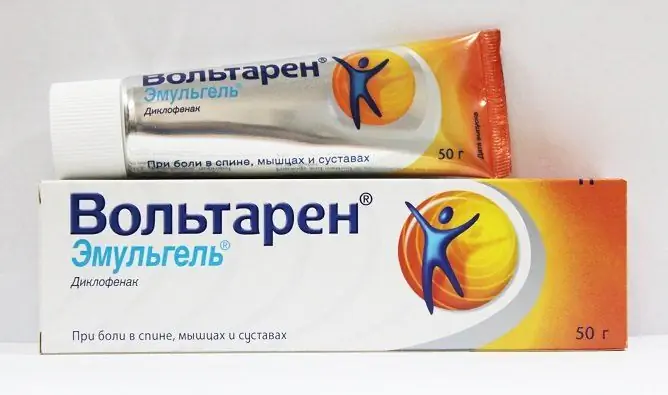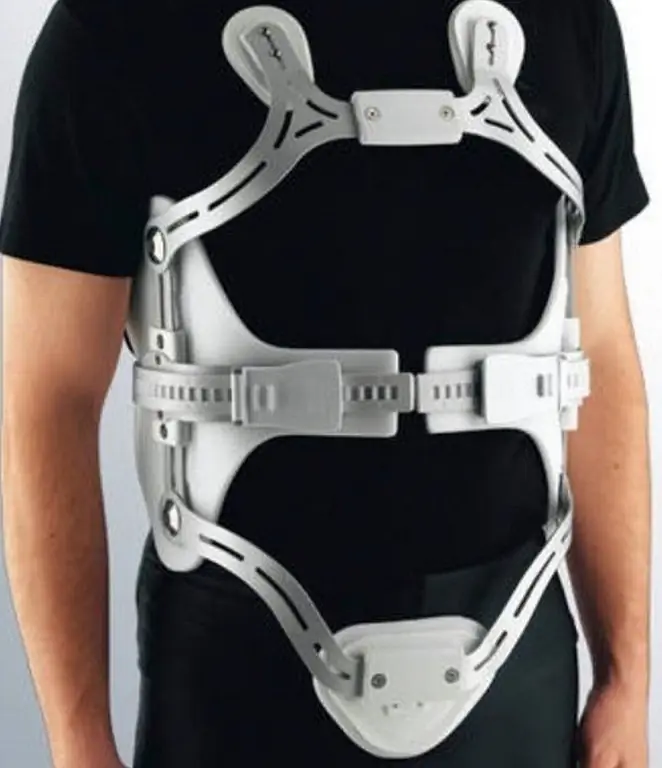- Author Rachel Wainwright [email protected].
- Public 2023-12-15 07:39.
- Last modified 2025-11-02 20:14.
Uncovertebral arthrosis
The content of the article:
- Causes and risk factors
- Stages
- Symptoms
- Diagnostics
- Treatment of uncovertebral arthrosis
- Possible complications and consequences
- Forecast
- Prevention
Uncovertebral arthrosis is a degenerative-dystrophic lesion of the intervertebral discs and joints of Lyushka in the cervical spine, accompanied by the formation of bone outgrowths (osteophytes) on the vertebrae against the background of gradual dehydration of the cartilage tissue and calcification of the ligaments. Osteophytes located on adjacent vertebrae and directed towards each other tend to interlock like hooks. Hence the name of the disease: uncovertebral (from the Latin uncus - hook and vertebra - vertebra) arthrosis.

Signs of uncovertebral arthrosis
Causes and risk factors
The prerequisites for the development of uncovertebral arthrosis are the anatomical features of the structure of the cervical spine. In addition to the facet joints, in the region of the C4 - C7 cervical vertebrae, in many people, additional joints are formed that connect the lunar protrusion of the lower vertebra with the lateral surface of the upper vertebra, which are called uncovertebral joints or Lyushka's joints. Their purpose has not been finally clarified; according to some assumptions, Lyushka's joints increase the range of motion in the cervical segment. An alternative point of view considers the uncovertebral joints as one of the early manifestations of degenerative-dystrophic changes in cartilage tissue.
Uncovertebral arthrosis is classified as a polyetiological disease. The development of the pathological process is facilitated by both internal and external factors:
- congenital anomalies of the structure of the vertebrae;
- flat feet;
- dysplasia of the head of the hip joint;
- injuries of the cervical spine;
- metabolic disorders;
- irregular physical activity;
- overweight;
- sedentary lifestyle.

Cervical spine injuries can lead to uncovertebral arthrosis
Stages
As the pathological process develops, four stages of uncovertebral arthrosis are distinguished.
- Moderate dehydration of the intervertebral disc with formed facet joints. The deterioration of the shock-absorbing capacity of the intervertebral disc is compensated by reflex muscle tension, which is why the patient is periodically disturbed by pronounced local pain and a feeling of stiffness in the neck, arising from sudden movements.
- There is instability in the cervical spine; facet joint subluxations become more frequent. The cartilage tissue gradually becomes thinner; protrusions begin to form - slight protrusions of the intervertebral disc forward and backward without rupture of the fibrous ring. Osteophytes appear on the surfaces of Lyushka's nearby joints, the ligaments gradually lose their elasticity and ossify.
- A further decrease in the height of the intervertebral disc leads to the formation of extrusions that compress blood vessels, nerves and soft tissues. There is a high likelihood of complications - radicular syndromes and vertebral artery syndrome with persistent cerebrovascular accident.
- The connection of osteophytes completely immobilizes the affected segment, the painful sensations subside.
Symptoms
In the early stages, the disease manifests itself almost in nothing. The only signal of possible trouble is acute burning pain with sharp bends and turns of the neck or after strong physical exertion, including lifting heavy loads.
For some time, the decrease in the elasticity of the intervertebral discs is compensated by the tension of the cervical muscles, against the background of which persistent muscle hypertonicity arises along with a tendency to myositis and congestion. For this reason, painful sensations in the neck are accompanied by a feeling of stiffness in the muscles and have a clear localization, indicating the location of the spasms.

The main symptom of uncovertebral arthrosis is burning pain with sharp turns or tilts of the neck
At the second stage of arthrosis, the pain in the neck takes on a permanent character and intensifies with a long preservation of one position; the mobility of the cervical spine is limited. Neck movements are accompanied by a pronounced crunch, indicating subluxation of the facet joints. With the spontaneous reduction of the subluxation, there is rapid relief.
Compression of nerve roots and blood vessels by the protruding edges of a deformed intervertebral disc can provoke additional symptoms:
- headaches and dizziness;
- violations of coordination of movements;
- deterioration of vision and visual disturbances (darkening in the eyes, flashes, flickering of colored flies);
- noise and stuffiness in the ears;
- vegetative disorders (palpitations, chills, cold extremities, sweating);
- fluctuations in blood pressure;
- drop attacks and fainting.
Sometimes, when the roots of the peripheral nerves are squeezed, patients are disturbed by frequent pain behind the sternum radiating to the scapula and shoulder, which can be mistaken for manifestations of a heart attack. To exclude cardiac pathology, consultation of a vertebrologist and a cardiologist is required.
Diagnostics
Diagnosis of uncovertebral arthrosis is a multi-stage process. A presumptive diagnosis is made on the basis of patient complaints, anamnesis and physical examination data by a specialist - a surgeon, vertebrologist, orthopedist or neurologist. When examining a patient, the doctor pays attention to painful areas in the cervical spine, muscle tone and neck mobility in general.

MRI is the gold standard for diagnosing uncovertebral arthrosis
The next step is instrumental studies that reliably reveal the specific signs of the disease - the presence of osteophytes, herniated intervertebral discs, damage to ligaments, muscles, nerves and blood vessels. MRI is considered the gold standard for the diagnosis of uncovertebral arthrosis due to high-quality imaging of hard and soft tissues. Radiography and CT of the cervical segment can confirm the presence or absence of osteophytes, but do not allow recognizing characteristic changes in soft tissues. To assess the degree of damage to blood vessels and the state of hemodynamics during prolonged compression, Doppler ultrasonography of the vessels can be prescribed.
Treatment of uncovertebral arthrosis
During periods of exacerbation, medical tactics are reduced to eliminating muscle spasm, relieving pain, restoring microcirculation in problem areas. To unload the muscles of the neck, wearing a fixing collar and the use of muscle relaxants are indicated. Inflammation that has arisen against the background of spasms is stopped with non-steroidal anti-inflammatory drugs that have analgesic effects, for example, Diclofenac or Nimesulide. With complicated extrusion and intractable pain syndrome, surgery may be required.
To restore the normal trophism of problem areas, blood supply stimulants are used. For this purpose, drug treatment of uncovertebral arthrosis is complemented by physiotherapeutic procedures, such as electrophoresis and phonophoresis with lidocaine and novocaine, magnetotherapy, shock wave therapy, amplipulse therapy, etc.

With uncovertebral arthrosis, the menu should include foods rich in collagens and B vitamins
The patient's diet should contain foods rich in natural collagen and B vitamins. The use of salt and hot spices should be limited. During remission, systematic exercise therapy is necessary: therapeutic gymnastics, water aerobics, swimming. Shown spa treatment according to the profile and massage courses two to three times a year
Alternative treatments for spinal diseases should be treated with great caution. It is permissible to resort to the services of osteopaths, reflexologists and chiropractors only during remission and with the permission of the attending physician. Extrusion is an absolute contraindication to manual therapy and osteopathy.
Possible complications and consequences
In a number of cases, uncovertebral arthrosis of the cervical spine is complicated by a herniated disc, radicular and compression syndromes caused by compression and permanent injury to the sympathetic nerve trunk, vertebral artery and vein. The development of vertebral artery syndrome is especially likely in cases of damage to the vertebrae C5 - C6 - in the place of natural narrowing of the bone canal.
Vertebral artery syndrome is a serious problem, since it entails a persistent violation of cerebral circulation and a significant deterioration in the quality of life due to prolonged migraine attacks, decreased visual acuity and hearing, autonomic and vestibular disorders. With severe compression of the vertebral artery, accompanied by fainting and severe ataxia, the question arises of assigning a disability group to the patient.
Forecast
In the early stages, uncovertebral arthrosis responds well to treatment - a complex course of therapy takes from one to two weeks; at a young age there is a chance to achieve a complete cure. In more advanced cases, the prognosis is cautious. To slow down degenerative-dystrophic processes and prevent complications, it will be necessary to undergo several intensive courses of therapy and consolidate the results achieved through supportive therapy.
Prevention
Prevention of uncovertebral arthrosis should be taken care of as early as possible, ideally even in the absence of complaints. It is important to lead a moderately active lifestyle, refrain from extreme stress and heavy lifting, eat rationally and give up bad habits. For sedentary work, doing neck relaxation exercises every 2-3 hours is helpful.
In case of injury to the cervical spine, do not self-medicate. Even if the case does not seem serious, you need to seek medical help and follow all medical recommendations. In the post-traumatic period, as well as in professional sports and in old age, profile spa treatment and courses of preventive massage are shown.
YouTube video related to the article:

Anna Kozlova Medical journalist About the author
Education: Rostov State Medical University, specialty "General Medicine".
The information is generalized and provided for informational purposes only. At the first sign of illness, see your doctor. Self-medication is hazardous to health!






